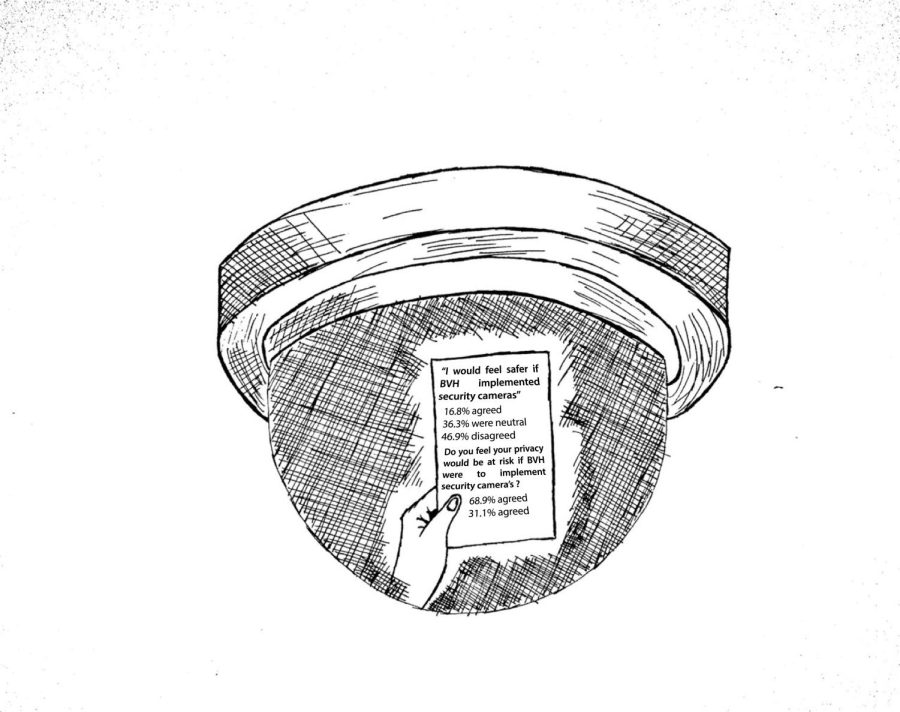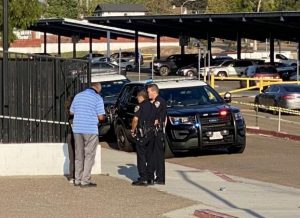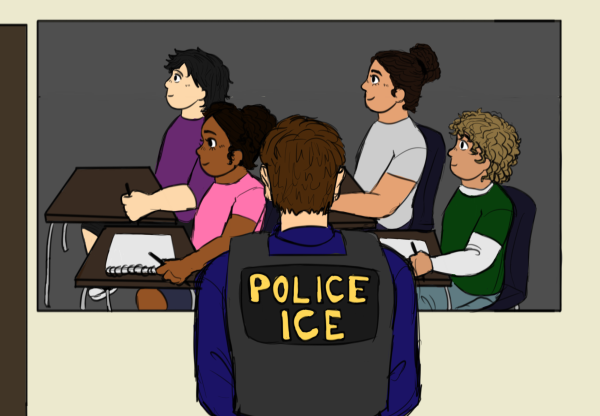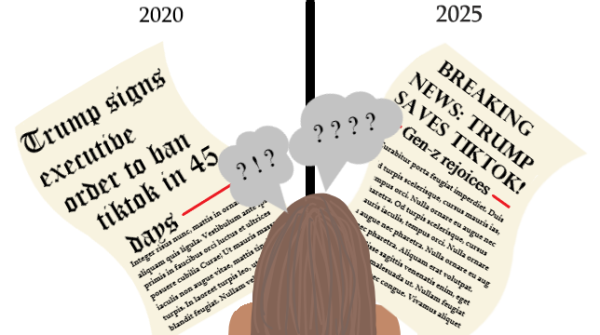Yes/No: Should schools implement security cameras on campus?
Data collected from BVH students by the Crusader who believe whether or not schools should implement security cameras.
Yes.
By: Antoinette Gilbert
A few months ago at Bonita Vista High (BVH), there were students that participated in “Devious Licks” — a TikTok challenge— by stealing school property. If schools were to install security cameras, the probability of these issues recurring would be low and students would be held accountable.
Security cameras can help students, teachers and other school staff members with controlling violence between students such as bullying and fights. According to stopbullying.gov, there are approximately 20 percent of students ages 12 to 18 years old that have experienced bullying.
Additionally, as stated by Centers for Disease Control and Prevention, there are approximately 18 physical-fighting incidents occurring per 100 students every month. By installing security cameras throughout school’s campuses, such as BVH, it ensures that there will be repercussions for those responsible.
School Security Cameras and Video Surveillance in Schools written by David Santiago, states that security cameras at school are known to ensure campus safety. They maintain the safety and peacefulness of the school’s environment, by recording any incidents that could occur.
For students, teachers and other staff members, school security cameras can create safer environments for teachers and students alike, because they decrease the possibility of theft, mischief and vandalism that had also occurred on BVH school grounds. Cameras placed on school campuses will help to prevent vandalism, break-ins, false fire-alarms, trespassing and other incidents.
A few weeks ago, students from an unidentified school trespassed the BVH campus. These same students vandalized the school by spray-painting antisemitic and homophobic statements on school property and breaking a window in room 907.
For others security cameras may cause problems for others personal privacy. Parents may not feel comfortable with their children being taped by the school without their permission as well, but they do ensure students safety.
Although some may argue that security cameras would lead to the lack of privacy, it is crucial to understand that security cameras are meant to keep students safe. Cameras should be installed not to invade a person’s privacy, but to protect schools by deterring criminal activity by providing material evidence when an incident has been caught on film. By the following as students vandalizing the school property and trespassing.
Stealing is a big problem that may still occur and needs to be stopped. Not too long-ago students have been stealing school supplies. The security cameras can be strategically placed in order to protect valuable school supplies like computers, equipment, trophies, books and other school supplies. Some reasonable places to place the school cameras would be in the classrooms.
According to the US National Liberty of Medicine National Institutes of Health, 15 percent of high school students have stolen in their life. If security cameras were to be implemented through school campuses, the percentages would decrease.
Security cameras are meant to record footage so people can watch it if needed. Security cameras can not stop crimes and they do not alert people like an alarm would. However, they can provide evidence that can assist with the incidents that may occur.
In conclusion, installing security cameras can make school grounds a safer place. Schools should install security cameras because they can determine misbehaviors. Additionally, they can also maintain the safety of students and school’s staff members.
No.
By: Madison Knudson
The topic of security cameras in schools creates vast arguments from opposing sides on whether or not they should be implemented throughout school campuses. Administrators and educators need to consider the many advantages and disadvantages of instituting different types of security, such as cameras throughout schools’ campuses. However, Bonita Vista High (BVH) needs to consider and examine the disadvantages a little closer regarding the implementation of cameras across campus.
According to Cons of Security Cameras in Schools by Cindy Pearce, cameras cannot be used in areas such as bathrooms and locker rooms due to legality purposes, where students and staff members have a reasonable expectation of privacy. Some people on campus may feel uncomfortable with the placement of cameras because it may be seen as an invasion of privacy. If there are violations of a student’s privacy, it can create legal liabilities. For example, if the security was installed or used incorrectly and the use of hidden cameras.
Additionally, many administrators and teachers are concerned about these cameras being used for harmful profiling: Targeting people who may look or present differently because of sexual orientaion, race, gender, religion, etc. These profiling justifications are unconstitutional violations of student and educator rights, mentioned by Pearce. The cameras meant to encourage the safety of students only contribute and encourage harmful stereotypes already present in society.
As reported by Keep Security Cameras Out of Schools by Gabrielle Applebury, students who have been around cameras in classrooms reported a feeling of distrust between the school and the student body, as well as teachers and educators. Furthermore, according to Pearce, some students and teachers may see the cameras as types of security measures that are used in prisons and therefore, inappropriate for school use. This also feeds into the stereotype of the schools being perceived as prisons which can increase the student crime rates due to more harsh environments.
Research shows that this surveillance causes a negative impact on student academic performance and achievement because students are less focused on their studies due to the constant surveillance. The hyperawareness of cameras littered across campus distracts from the education in front of them. It also creates division between students and how they contribute to the culture of the school because they are set aside in an attempt to make schools safe.
In relation, “Adding Security, but Subtracting Safety? Exploring Schools’ use of Multiple Visible Security Measures,” by Emily E. Tanner-Smith, Benjamin W. Fisher, Lynn A. Addington and Joseph H. Gardella, claims that crimes in school settings don’t only involve property damage but also include issues such as youth exposure to drugs, fighting, firearms at school and more. Through analyzing data, they were able to find indications that utilization of security measures in high schools reduced the exposure to property crime, however they were also associated with poorer school safety.
Vandalism of the cameras, such as stealing or destruction, can also occur if there isn’t a way to monitor the condition of the cameras themselves regularly. With the recent vandalism at BVH, stealing and destruction of the cameras should not be rejected as a possibility if they were to be implemented on campus beforehand. There is also the possibility of someone in the school’s system who has access to the cameras to prevent them from working at certain times in some places where students’ actions will not be held accountable for the actions done because they were not visible by the cameras.
Despite the fact that principal Roman Del Rosario spoke on the vandalism and mentioned the funds provided to BVH by the Sweetwater Union High School District (SUHSD) after returning from distance learning, the cost of security and surveillance is still very expensive. For example, an Ohio school district spent over 82,500 dollars in cameras over five years and software installation and setup for the cameras, as well as a 28,000 dollar annual fee. Although the installation of the products may be the most costly, there are other added expenses such as operation of the cameras, maintenance of the cameras themselves and monitoring of the surveillance.
Although some students and parents might disagree with the installation of security cameras due to privacy reasons, according to Applebury, the Family Education Rights and Privacy Act is a Federal law that protects the privacy of student education records. The law applies to all schools that receive funds under an applicable program of the U.S. Department of education. Therefore, the security footage of students must be stored appropriately. Adding on, the act states that parents and students have the right to inspect the footage of the students. Schools must also have a signed form in order to release any of this footage. Through all the investments and expenses needed to install and maintain security cameras, they have proved to be not as helpful as many schools may need.
Considering the recent events that took place at BVH, it’s understandable to look at the benefits of implementing cameras on campus. However, with the installation of cameras comes numerous factors that go against the same idea.

I am a junior at Bonita Vista High and this is my third year being a part of the Crusader staff. I am currently the Arts and Cultures Editor this year...

I am a senior at BVH and this is my fourth year in the Crusader. I am currently the News Editor and was previously a Staff writer, Opinion Editor, and...

Hi readers! I’m a senior at BVH and going into my fourth and final year in the Crusader. I’ve enjoyed the past three years of being on staff and while...







Maddie E. • Dec 20, 2022 at 10:40 am
I’m I high school senior at Winfield High School in West Virginia, and this website is the coolest thing I’ve ever seen. I looked up Bonita Vista High, and it blows my mine that there can be 2,300 students under one roof. Winfield only has about 800 students, and the largest high school in WV is 1,300 students.
I am doing research for a final English 101 paper and this was one of the top results. I read it and didn’t even realize it was written by high school students until I got to the contributors section at the bottom.
again, I love this! you can now say that your school newspaper has reached the East Cost!
Mr. Gervais • Dec 16, 2021 at 11:08 am
Thank you for this thoughtful debate; in the end a cost analysis would determine if the cost of distruction caused by deviant behavior is worth the fees implemented to set-up and maintain a security surveilance system. Is the new video security cost effective overall?
The other arguements are worthy of notice and basic discussion but I wonder if we feel differently knowing we are on camera walking into convenience stores, major markets and shopping malls? Do you feel like a criminal at major sporting venues or driving through video cameras at major crossings, or while riding mass transit in the city?
There are strategic trouble spots on campus that need special consideration for increased surveillance. This is a concern but what is the cost benefits to technology prevention?
Finally, another loss prevention technology system could also alleviate deviant behavior; our school identification cards. Perhaps a system where all students swipe in and out of all rooms using their IDs like employess do in many building of business. A digital log can be kept of all students attendance and their movements around campus during the school day, icluding bathroom access. Perhaps the bathroom entry can be blocked if the bathroom is above capcity. Does this solve problems? No it does not, but it may deter movement during school hours. Alwas, we return to my first, quandry, Is this Cost Effective?